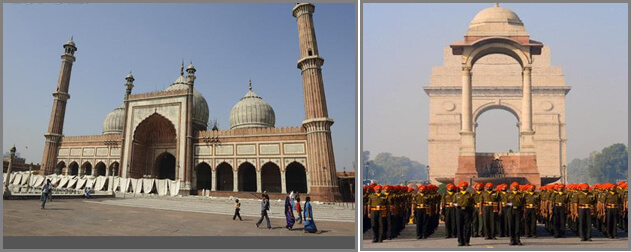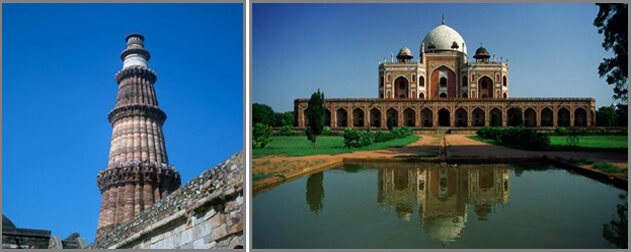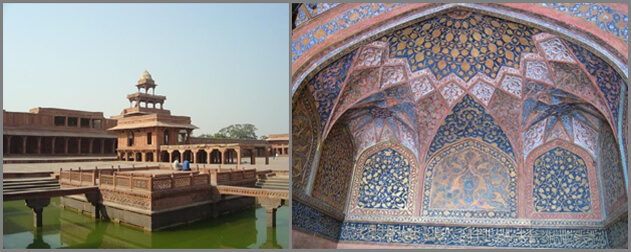6 days Golden Triangle Trip – Delhi / Agra / Jaipur
Day 1 – Arrive Delhi
Upon arrival at Delhi airport meet our representative. Welcome accorded with a traditional floral garland & private transfer to hotel
Welcome to Delhi !
Delhi – India’s Past and Its Future
“I asked my soul what is Delhi? It replied, the world is the body, Delhi is its soul….. “ is how a 19th century poet described this city that has ever been so many things to so many different people. To the weary travellers on the ancient silk route it was the first plain after having crossed the Himalayan Mountains with the promise of shelter, food and business opportunities. To the Afghan, Turk, Greek, Arab and Roman kings, it was a vast and inexhaustible source of treasures of all kinds, to the Chinese travellers, it was the land of knowledge and wisdom. Its ageless face saw the advent of Islam,¬ it saw empires being built and destroyed or even merely dismantled to make way for the new ¬and Delhi lived on….
The British created their own Delhi ¬with large well planned avenues and planted 10000 trees with a 112 kms of hedges that it would be green round the year abundant with flowers ¬ a botanical paradise. The seat of the British Empire, Delhi of 1911 was planned to resemble ‘an Englishman dressed for the climate’. Its planners and main architects decided that it would be neither Hindu, nor Muslim, nor Buddhist, nor English nor Roman but IMPERIAL a house for the Viceroy that resembled a “giant Indian bungalow, embattled Rajput fortress and Mughal tomb ¬ with shades of Buckingham Palace ¬ with English country house comforts”.
Delhi is perhaps the only city in the world that fuses its past present and evokes its future without losing an iota of its identity. ¬ 1300 monuments speak of her antiquity, of the ambitions of men who thought they could hold on to her ¬ but history proved otherwise. A popular superstition is that it is also known as the ‘graveyard of dynasties’ with every one of its cities built there heralding the death the dynasty that built it.
Thus, Delhi is a Melting Pot of cultures, politics and religions of India’s colorful past in its monuments, its palaces, and in the faces of its people that themselves narrate the story of their glorious past.
After lunch sightseeing tour of Old Delhi.
You will first visit Old Delhi. The tour will begin with a visit to Raj Ghat, a simple memorial to Mahatma Gandhi; you will than drive past Red Fort- the magnificent Red Fort, overlooking the river Jamuna was built during the years 1638 - 48 when the Mughal Empire was at its peak. The tour continues to Jama Masjid, one of Asia’s largest mosques and which is viewed from the outside. People stream in and out of the mosque continuously and the presence of a nearby bazaar means that the area is rarely quiet. Overnight at Delhi

Day 2 – In Delhi
After breakfast Full day city tour of New Delhi.
New Delhi, which reflects the legacy the British left behind. The division between New and Old Delhi is the division between the capitals of the British and the Mughal respectively. The walled city is all tradition where one will be able to glean a past life-style in all its facets, colour and spells. New Delhi in contrast, is a city trying to live up to the best of 21st century standards.
The tour to Imperial Delhi will include a visit to the Qutub Minar, which is the tallest stone tower in India. The Qutub Minar was started in 1199 AD by Qutub-ud-Din Aibak and completed by the sultan's successor and son-in-law, Iltutmish. The building is 72.5 m high and has 379 steps from the bottom to the top. The Minar is tapering with the diameter of the base is 14.3 m while at the top floor it is2.7 m. The Qutub Minar is still the highest stone tower as well as one of the finest Islamic structures ever raised in India. Then visit Humayun’s tomb, built by the widow of the second Mughal Emperor, Humayun, it is an outstanding monument in the Indo-Persian style, a precursor of the Taj Mahal. The tour also includes a drive past the imposing India Gate, the Parliament building and the Rashtrapati Bhawan, the President’s residence. Overnight at Delhi

Day 3 – Delhi – Agra (approx. 200 Km 4 Hrs.)
After breakfast drive to Agra.
Agra – The city that created the most extravagant monument ever built for love.
Agra city is a virtual gateway to a world of discovery. It has witnessed the rise of the pomp and pageantry of three great Mughal monarchs - Akbar, Jehangir and Shah Jehan, all of whom lavished on this fabled city, their love and riches to transform the land into one of the greatest centres of art, culture, learning and commerce. Much of the city's impressive past lives in evidence even today, in the haunting presence inside the monuments and in the majesty of the buildings.
It is said that the world is divided into two parts; those who have seen the Taj Mahal and those who have not.
In the afternoon you will be visiting Agra Fort, an outstanding example of Mughal architecture. Agra Fort - the seat and the stronghold of the Mughal Empire under successive generations. This was the seat of Mughal rule and administration and the present structure owes its origins to Akbar who erected the walls and gates and the first buildings on the eastern banks of Yamuna River. Shah Jehan added the impressive quarters and the mosque while Aurangzeb added the outer ramparts. Visit its Hall of Public Audience and its Royal Pavilions.
Later proceed for sunset visit to The Taj Mahal (closed on Fridays). The Taj Mahal is everything that has been said about it and more. Taking 22 years and 20,000 men to build, the white marble was quarried 200 miles away and was transported to the site by a fleet of 1000 elephants. Built by the Mughal Emperor Shah Jahan as an expression of his love for his wife Mumtaz Mahal, in mid 17th century, the Taj Mahal is truly one of the wonders of the world. Though the Taj appears to be amazingly perfect from almost any angle, it is the close-up marble inlay work, which is really astounding. You will have ample time to view and be mesmerized by this outstanding piece of architecture. Overnight at Agra.

Day 4 – Agra – Jaipur enroute Fatehpur sikri (approx. 240 Km / 5 Hrs.)
Morning after breakfast drive to Jaipur. en-route visiting Fatehpur Sikri, the deserted red sandstone city, built by the Great Mughal Emperor Akbar as his capital and palace in the late 16th century. It was abandoned soon after it was built when the local wells went dry and it remains today in much the same condition that it was over 300 years ago. It is complete with palaces and mosques and used to be a town larger than London when it was originally constructed. Now it is an extraordinary place to wander around with its buildings in near perfect condition.
Later drive to Jaipur
Rajasthan’s kingdoms are an enduring legacy to India’s history. A land endowed with invincible forts, magnificent palaces ad waves of sand dunes and serene lakes. No other region in the country assembles the many paradoxes of India, as does the desert land of Rajasthan. By far it is the most colourful region in India.
Jaipur's past is never too far from hand. The city of victory, Jaipur presides over the fascinating desert state and its people: surrounded by rugged hills, each crowned by a formidable fort; and beautiful palaces, mansions and gardens dotted throughout its precincts. The palaces and forts of yesteryear that were witness to royal processions and splendour are now living monuments, accepted quite naturally into the lifestyles of the people of the "pink city". Except for the busy traffic of bicycles, cars and buses, little seems to have changed. There is a timeless quality to Jaipur's bazaars and its people. With its historical past, Jaipur revives legends of the ancient Rajputs. The dresses of the women and the turbans of the men add colour to this fascinating city.
Upon arrival, proceed for check-in at your hotel.
Overnight at Jaipur

Day 5 - In Jaipur
After breakfast full day city tour in Jaipur.
Amber Fort. Maharaja Mansingh, Mughal Emperor Akbar’s most successful General, started the construction of Amber Fort in the 17th century. Before the City Palace was constructed in Jaipur, Amber was the seat of power. The fort is surrounded by fortified battlements and overlooks the Moat Lake. Ruins and remains are spread over the Aravalli hills and sprawling crenulated walls lattice the surrounding area.
An elephant (alternatively by jeeps) will spare you the trouble of reaching up to the fortress. Once you are at Fort, stroll through the sprawling complex of courtyards and halls. Many of the rooms have delightful wall paintings, with precious stones and mirrors inlaid in the walls. Most fascinating, perhaps, is the Sheesh Mahal (hall of mirrors) where a single lamplight is reflected in the many mirrors, lighting up the room.
En-route to Amber Fort you will stop and see the 'Palace of Winds', otherwise known as Hawa Mahal. It is really an elaborate facade behind which the ladies of the court used to watch the daily goings on in the street below. It is extremely intricate in its pink sandstone carving. The cool wind blows through its facade of windows and latticed screens through which the queens of the court once viewed the streets of the city. Overnight at Jaipur.

Day 6 – In Jaipur / Departure
Morning after breakfast sightseeing in Jaipur.
City Palace, which is an overwhelming complex of exquisite palaces, gardens and courtyards, decorative art and carved doorways. The palace museum houses collections of rare manuscripts, armoury, costumes, carpets and miniature paintings.
Jaipur's Jantar Mantar is the most famous of five observatories built by Sawai Jai Singh in India. Jai Singh was a great admirer of progresses and research made in the fields of science and technology, but he was passionate about astronomy. There is a very interesting story behind the construction of this observatory, considered as the largest stone observatory in the world. Sawai Jai Singh sent his emissaries to all parts of the world before commencing the construction of this observatory. The emissaries returned with many manuals on astronomy containing cutting-edge technological information. One of these manuals was a copy of La Hire's "Tables". The king ordered the observatory to be built according to the details contained in this manual. When the construction ended, for the astonishment of the king and others, the observatory was 20 seconds more accurate than the one mentioned in "Table.
Afternoon either drive back to Delhi ( 275 kms / 6 hours ) or drop to Jaipur Airport.
Our package shall include private Ac car, local English speaking guides during sightseeing, monument entrance tickets and accommodation in 5 star hotels including breakfast for 5 nights.
